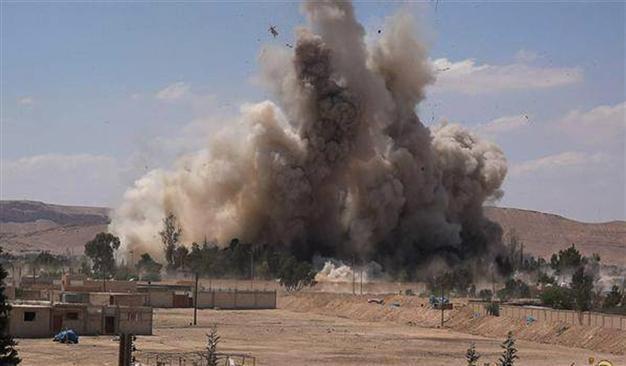ISIL advances in Syria against both regime and rival rebels
BEIRUT – Agence France-Presse

AP Photo
The Islamic State oıf Iraq and the Levant (ISIL) group seized territory from both Syrian government forces and rival rebels over the weekend further expanding the caliphate it has proclaimed straddling Iraq and Syria.
The Syrian Observatory for Human Rights said that following gains in both Homs province in the center and Aleppo province in the north, IS now controlled half of the country’s land area.
Geographer and analyst Fabrice Balanche said that across Iraq and Syria, the jihadist group now controlled nearly 300,000 square kilometers, an area the size of Italy.
In Aleppo province - on Syria’s border with Turkey – ISIL has expanded its control at the expense of rival rebel groups.
ISIL captured the village of Suran on May 31 taking them to within 10 kilometers of the border, the Observatory said.
Three days of heavy fighting left 30 ISIL fighters and 45 rival rebels dead, the Britain-based watchdog said.
On June 1, the group advanced towards the town of Marea, which lies on a key supply route from Turkey for its rebel opponents.
ISIL previously targeted Marea in April, detonating two car bombs and killing 15 rebel fighters, but it was unable to take the town.
In central Syria, ISIL ousted government forces on Saturday from a strategic crossroads south of the ancient oasis city of Palmyra. The checkpoint and nearby village of Basireh lead south to Damascus and west to Homs, as well as east to ISIL-controlled areas of Iraq.
“The road is now open [for ISIL) from Palmyra to Anbar province in Iraq, without any obstacles,” said local activist Mohammed Hassan al-Homsi.
ISIL overran Palmyra on May 21 after a bloody advance across the desert from their stronghold in the Euphrates valley to the east.
The city’s fall came hot on the heels of the jihadists’ capture of Anbar provincial capital Ramadi from Iraqi government forces.
That defeat forced Baghdad to call in Iran-backed Shiite militia forces to the predominantly Sunni province in a move that risks complicating its efforts to win the population back from the extremists of ISIL.
An Iranian officer was killed last week while advising Iraqi forces on their campaign to recapture Ramadi, Iranian state media reported on June 1.
In northeastern Syria, ISIL has advanced to within two kilometers of the provincial capital of Hasakeh, the Observatory said.
On June 1, “an ISIL fighter blew himself up at a pro-government checkpoint near Hasakeh, killing at least nine regime loyalists,” it added.
Syrian government forces have proved increasingly unwilling to fight ISIL in areas that are regarded as marginal.
For the regime, “the territories that are vital to protect... are Damascus, Homs, Hama, and the coast,” a security source said.
Observatory director Rami Abdel Rahman said the government was suffering from a severe shortage of military personnel both because of heavy battlefield losses and because of difficulties recruiting replacements.
“The armed forces and pro-government militia are unwilling to fight in areas where the local population isn’t also fighting,” he told AFP.
In particular, soldiers were hesitant to get involved in areas with a Sunni Muslim majority, compared to those which are largely Alawite -- the offshoot of Shiite Islam to which President Bashar al-Assad belongs.
A pro-regime Facebook page publishing news from the Assad heartland of Latakia lamented the “thousands of martyrs and wounded” that coastal provinces had suffered during the war, demanding that other areas take up arms so that minorities would not carry the burden alone.
Analyst Aron Lund said that ISIL and its Syrian government and rebel opponents were engaged in a bloody multi-front war in which there would be no winners.
“Cities will be taken and retaken, and battles will be won and lost, until we all lose track,” he said.
“But you cannot win a war like Syria’s any more than you can win a plague or an earthquake.”
